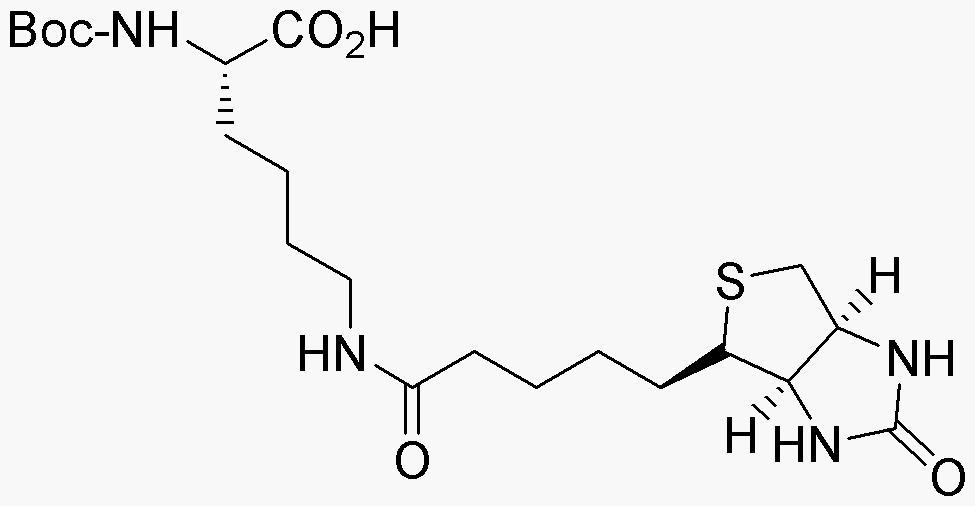Na-Boc-Ne-biotinyl-L-lysine is widely utilized in research focused on:
- Bioconjugation: This compound serves as a versatile linker in bioconjugation processes, allowing researchers to attach biomolecules like proteins or antibodies to surfaces or other molecules, enhancing the study of biological interactions.
- Drug Development: In pharmaceutical research, it is used to create biotinylated drug candidates, which can improve targeting and delivery mechanisms, making treatments more effective.
- Diagnostics: The compound plays a crucial role in developing diagnostic assays, particularly in the detection of biomolecules, where its biotinylation properties facilitate easy binding to streptavidin-coated surfaces.
- Protein Purification: It is employed in affinity chromatography for the purification of proteins, leveraging its strong affinity for streptavidin, which simplifies the isolation of desired proteins from complex mixtures.
- Cell Biology: Researchers use this compound in cell labeling and tracking studies, allowing for the visualization of cellular processes and interactions in real-time, which is vital for understanding cellular functions.
General Information
Properties
Safety and Regulations
Applications
Na-Boc-Ne-biotinyl-L-lysine is widely utilized in research focused on:
- Bioconjugation: This compound serves as a versatile linker in bioconjugation processes, allowing researchers to attach biomolecules like proteins or antibodies to surfaces or other molecules, enhancing the study of biological interactions.
- Drug Development: In pharmaceutical research, it is used to create biotinylated drug candidates, which can improve targeting and delivery mechanisms, making treatments more effective.
- Diagnostics: The compound plays a crucial role in developing diagnostic assays, particularly in the detection of biomolecules, where its biotinylation properties facilitate easy binding to streptavidin-coated surfaces.
- Protein Purification: It is employed in affinity chromatography for the purification of proteins, leveraging its strong affinity for streptavidin, which simplifies the isolation of desired proteins from complex mixtures.
- Cell Biology: Researchers use this compound in cell labeling and tracking studies, allowing for the visualization of cellular processes and interactions in real-time, which is vital for understanding cellular functions.
Documents
Safety Data Sheets (SDS)
The SDS provides comprehensive safety information on handling, storage, and disposal of the product.
Product Specification (PS)
The PS provides a comprehensive breakdown of the product’s properties, including chemical composition, physical state, purity, and storage requirements. It also details acceptable quality ranges and the product's intended applications.
Certificates of Analysis (COA)
Search for Certificates of Analysis (COA) by entering the products Lot Number. Lot and Batch Numbers can be found on a product’s label following the words ‘Lot’ or ‘Batch’.
Numéro de catalogue
Numéro de lot/série
Certificates Of Origin (COO)
This COO confirms the country where the product was manufactured, and also details the materials and components used in it and whether it is derived from natural, synthetic, or other specific sources. This certificate may be required for customs, trade, and regulatory compliance.
Numéro de catalogue
Numéro de lot/série
Safety Data Sheets (SDS)
The SDS provides comprehensive safety information on handling, storage, and disposal of the product.
DownloadProduct Specification (PS)
The PS provides a comprehensive breakdown of the product’s properties, including chemical composition, physical state, purity, and storage requirements. It also details acceptable quality ranges and the product's intended applications.
DownloadCertificates of Analysis (COA)
Search for Certificates of Analysis (COA) by entering the products Lot Number. Lot and Batch Numbers can be found on a product’s label following the words ‘Lot’ or ‘Batch’.
Numéro de catalogue
Numéro de lot/série
Certificates Of Origin (COO)
This COO confirms the country where the product was manufactured, and also details the materials and components used in it and whether it is derived from natural, synthetic, or other specific sources. This certificate may be required for customs, trade, and regulatory compliance.


